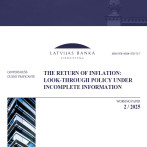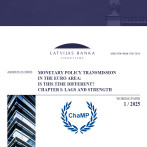What’s the price we are going to pay for electricity?

In short
-
High electricity prices reflect high natural gas prices;
-
during the coming heating season, the government will provide tangible support to households, compensating a significant part of the increase in electricity prices, but the support depends on the amount of electricity consumed;
-
the government support to compensate for high electricity prices will reduce inflation;
-
a sharp drop in electricity prices is not expected in the future – this encourages households to rethink the spending and the change of electricity consumption habits.
Electricity prices have surged in Latvia since 2021. On the Nordpool exchange, they rose from a typical 50 EUR/MWh in the first half of 2021 to 200 EUR/MWh in October 2022. Within a year and a half, the rise in electricity prices is impressive – they have quadrupled (see Figure 1). Similar electricity price trends can also be observed in several neighbouring countries which use natural gas in the electricity production. What electricity bills will we pay next year?
Natural gas prices have a significant impact on electricity prices
In the Nordic region, electricity is produced from several sources – hydro and wind power plants, nuclear power, coal and natural gas power plants. The availability of each type of source of electricity, the installed production capacity and the inter-regional transmission capacity determine the electricity prices in any given region. In Latvia, half of the electricity is produced in hydro and wind power stations, the operation of which depends on weather conditions, not natural gas prices. The rest is produced using natural gas. This fact explains why natural gas and electricity prices comove closely in Latvia (see Figure 1).
Our estimates show that a rise in natural gas prices passes through to electricity prices quite quickly, but not completely. On average, a 10% increase in natural gas prices pushes up electricity prices by approximately 5% (see Figure 2), where half of the impact is already passed through in the second month. The pass-through is fast because the costs of natural gas account for the lion's share of the total costs of electricity production.
Notes: Figure 1 reflects TTF natural gas prices and projections (gas futures dated on 23 November 2022) and Nordpool exchange electricity prices in Latvia, as well as projections (our own model projections). The grey area depicts the projection horizon. Figure 2 shows a pass-through from natural gas prices to electricity prices using a cointegrated ARDL approach (ARDL(1,0) model with trend and constant. Cointegration is assessed using the ARDL bounds test and that is statistically significant at α<0.01. The long-run coefficient between natural gas and electricity prices is 0.52.
The exchange price of electricity is only part of the total electricity bill
In the last decade, relatively stable natural gas prices in European markets ensured limited electricity price fluctuations in Latvia. However, residents could have barely noticed fluctuations of the electricity prices in their electricity bills. The reason for this is the fact that the price of electricity is only part of the total bill. Until the middle of 2021, the price of electricity (Nordpool exchange price and retailer's markup) made up about a third of the total bill, with the rest being made up of electricity transmission and connection costs, the compulsory procurement component (CPC) and taxes [1].
The situation has changed dramatically since mid-2021. Electricity exchange prices have significantly and steadily risen and are reflected accordingly in retail prices and electricity bills [2] (see Figure 3). As the Nordpool prices grew, the share of electricity prices also increased in household bills – up to 70%, overshadowing other components of the final bill. The average bill for an ordinary household in Latvia has increased 2.4 times – from 16 EUR on average in 2020 to 40 EUR in September 2022 (per 100 kWh) [3].
Notes: we use “Elektrum ekonomiskais” as popular tariff contract showing electricity price per 100 kWh, 6-month moving average. Retailer’s price comprises the exchange price + retailer’s margin. CPC is the compulsory procurement component. The grey area depicts the projection horizon. Electricity bill’s projections are based on Nordpool price projections and retailer’s margin for fixed tariff contracts equal to 0.03 EUR/kWh. It is expected that CPC and fixed CPC components will be compensated up to 2025 according to Cabinet Order No 584.
Government support will reduce household electricity bills and significantly affect inflation
The extremely sharp increase in electricity prices urged governments across Europe to support households and compensate some of the electricity costs. The Latvian government has decided to compensate the CPC and to introduce the electricity price cap from October 2022 to April 2023. As a result, the government compensates households the difference in electricity prices above 0.16 EUR per 1 kWh [4]. This applies to the first 100 kWh consumed within a month, however, considering that half of the households consume no more than 100 kWh, the support is substantial. The government support is expected to compensate households up to 46% of their total electricity bill (of course, estimates depend on the Nordpool market price and the retailer's markup). As a result, electricity bills in October 2022 decreased by an average of 35% compared to September. Alternatively, bills would increase by 10% without the government support.
But how will the government support affect inflation? It’s important to remember here that the government has introduced two caps:
- the price cap, i.e. the consumer pays for electricity no more than 0.16 EUR/kWh and
- the volume cap, i.e. the government applies a price cap only to the first 100 kWh consumed. The first criterion determines the extent to which the price of electricity for households will decrease. The second criterion determines the extent to which the reduction in electricity prices will affect household bills. Thinking about inflation, electricity bills are important, not electricity prices.
To evaluate the impact on household bills and inflation, considering the volume cap, the distribution of households by the amount of electricity consumed should be known. The latest data for 2022 show that most households will fully enjoy government support and the price cap – 55% of households' monthly electricity consumption does not exceed 100 kWh (see Figure 4). Up to 80% of households (with consumption up to 200 kWh) will receive significant support from the government. Households with consumption above 200 kWh will receive support, but it will be relatively smaller. It is assumed that the government support will protect the most vulnerable households from the surge in electricity prices.
Notes: data of household distribution by volume of electricity consumption are on average over January-September 2022. The coefficients of pass-through are obtained without taxes and other fixed costs.
It is expected that, on average, the pass-through of the reduction in electricity prices to household bills (excluding taxes and other fixed costs) will be high, as most households consume no more than 100 kWh. The pass-through means that a 10% reduction in electricity prices will reduce household electricity bills on average by 8%, i.e. the pass-through coefficient is 0.8 (see figure 5) [5].
What reduction in electricity bills could households expect? As we have already discussed, the drop depends on the amount of electricity consumed. Our estimates show that households with consumption up to 100 kWh will enjoy most of the benefits provided by the government support, and their bills will decrease by 35%. The drop in Latvia, on average, is expected to be slightly less – around 28% (see Figure 6).
The government support reduces not only bills, but also inflation. Our estimates show that overall inflation will be 0.78 percentage points lower already this year. However, the government support will end in 2023, and electricity prices are expected to rise and remain above the average of 2022. Thus, the termination of government support (or price increase) will have a positive effect on inflation in 2024 (see figure 7).
Notes: Figure 6 shows a drop in the electricity bill by volume of consumption considering the price cap, volume cap and CPC reduction. The electricity price with a cap and without is 0.16 EUR/kWh and 0.27 EUR/kWh respectively – the price of electricity in September 2022 for the “Elektrum Ekonomiskais” tariff contract (6-month moving average). Figure 7 assesses the impact as scenario with the government support minus the scenario without the government support. The scenario of electricity prices without the government support is obtained using econometric models at Latvijas Banka. The assessment includes the government support provided from September 2022 to April 2023, but excludes the support provided in January-April 2022.
Conclusions
It is expected that natural gas prices will remain at high levels in the future. Given the existing electricity generating capacity and its type, natural gas prices will play a significant role in determining electricity prices. While a slight ease in electricity prices is expected, they will still remain well above the level of 2021.
Over the next half year, the government will provide a tangible support to households to ease the impact on household spending. It is expected that the support will compensate up to 46% of the possible households’ electricity bills and reduce inflation by 0.78 percentage points already this year. Moreover, the government support is targeted at the most vulnerable households with a low electricity consumption and protects them from the sharp increase in electricity bills. The bills were already 35% lower in October. Alternatively, they would have been 10% higher without the government support.
Nonetheless, the government support will end in April next year, and electricity prices are expected to remain at a high level. This encourages households to rethink their spending and change their habits of electricity consumption. At the national level, it would be important to support and motivate entrepreneurs and households to improve energy efficiency, switch to more sustainable sources of electricity aiming to reduce the impact of energy price fluctuations on household spending in the future.
[1] An important role is played by the tariff contract – dynamic or fixed – chosen by the consumer. In the case of a fixed tariff plan, the price is fixed for some time, but the difference between the fixed tariff and the exchange electricity price is borne by the supplier in the profit-loss form.
[2] Basically, reflecting an increase in natural gas prices. See our previous blog
[3] A typical household in Latvia consumes no more than 100 kWh per month (see Figure 4) and has a fixed tariff contract (85% of households have a fixed tariff contract according to Public Utility Commission data in the 2nd quarter of 2022).
[4] For example, if the retailer’s price is 0.20 EUR/kWh, the government compensates 0.04 EUR/KWh.
[5] A pass-through from electricity prices to electricity bill depends on how much electricity a household consumes above 100 kWh. If a household consumes exactly 100 kWh, the pass-through is full or one. If a household consumes 125 kWh, the government compensates the price difference for the 100 kWh, but 25 kWh is paid at market price. Hence the pass-through is lower, only 0.8.
Textual error
«… …»






